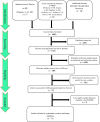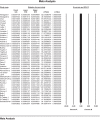Global prevalence of Duchenne and Becker muscular dystrophy: a systematic review and meta-analysis
- PMID: 35168641
- PMCID: PMC8848641
- DOI: 10.1186/s13018-022-02996-8
Global prevalence of Duchenne and Becker muscular dystrophy: a systematic review and meta-analysis
Abstract
Background: A variety of mutations in the largest human gene, dystrophin, cause a spectrum from mild to severe dystrophin-associated muscular dystrophies. Duchenne (DMD) and Becker (BMD) muscular dystrophies are located at the severe end of the spectrum that primarily affects skeletal muscle. Progressive muscle weakness in these purely genetic disorders encourages families with a positive history for genetic counseling to prevent a recurrence, which requires an accurate prevalence of the disorder. Here, we provide a systematic review and meta-analysis to determine the prevalence of DMD and BMD worldwide.
Method: The current systematic review and meta-analysis was carried out using Cochrane seven-step procedure. After determining the research question and inclusion and exclusion criteria, the MagIran, SID, ScienceDirect, WoS, ProQuest, Medline (PubMed), Embase, Cochrane, Scopus, and Google Scholar databases were searched to find relevant studies using defined keywords and all possible keyword combinations using the AND and OR, with no time limit until 2021. The heterogeneity of studies was calculated using the I2 test, and the publication bias was investigated using the Begg and Mazumdar rank correlation test. Statistical analysis of data was performed using Comprehensive Meta-Analysis software (version 2).
Results: A total of 25 articles involving 901,598,055 people were included. The global prevalence of muscular dystrophy was estimated at 3.6 per 100,000 people (95 CI 2.8-4.5 per 100,000 people), the largest prevalence in the Americans at 5.1 per 100,000 people (95 CI 3.4-7.8 per 100,000 people). According to the subgroup analysis, the prevalence of DMD and BMD was estimated at 4.8 per 100,000 people (95 CI 3.6-6.3 per 100,000 people) and 1.6 per 100,000 people (95 CI 1.1-2.4 per 100,000 people), respectively.
Conclusion: Knowing the precise prevalence of a genetic disorder helps to more accurately predict the likelihood of preventing its occurrence in families. The global prevalence of DMD and BMD was very high, indicating the urgent need for more attention to prenatal screening and genetic counseling for families with a positive history.
Keywords: Becker; Duchenne; Meta-analysis; Muscular dystrophy; Systematic review.
© 2022. The Author(s).
Conflict of interest statement
The authors declare that they have no conflict of interest.
Figures




References
-
- Mah JK, Selby K, Campbell C, Nadeau A, Tarnopolsky M, McCormick A, et al. A population-based study of dystrophin mutations in Canada. Can J Neurol Sci. 2011;38(3):465–474. - PubMed
-
- Hammonds RG., Jr Protein sequence of DMD gene is related to actin-binding domain of α-actinin. Cell. 1987;51(1):1. - PubMed
-
- Davison MD, Critchley DR. alpha-Actinins and the DMD protein contain spectrin-like repeats. Cell. 1988;52(2):159–160. - PubMed
-
- Aartsma-Rus A, Van Deutekom JC, Fokkema IF, Van Ommen GJB, Den Dunnen JT. Entries in the Leiden Duchenne muscular dystrophy mutation database: an overview of mutation types and paradoxical cases that confirm the reading-frame rule. Muscle Nerve. 2006;34(2):135–144. - PubMed
-
- Ibraghimov-Beskrovnaya O, Ervasti JM, Leveille CJ, Slaughter CA, Sernett SW, Campbell KP. Primary structure of dystrophin-associated glycoproteins linking dystrophin to the extracellular matrix. Nature. 1992;355(6362):696–702. - PubMed
Publication types
MeSH terms
Substances
Grants and funding
LinkOut - more resources
Full Text Sources
Medical

